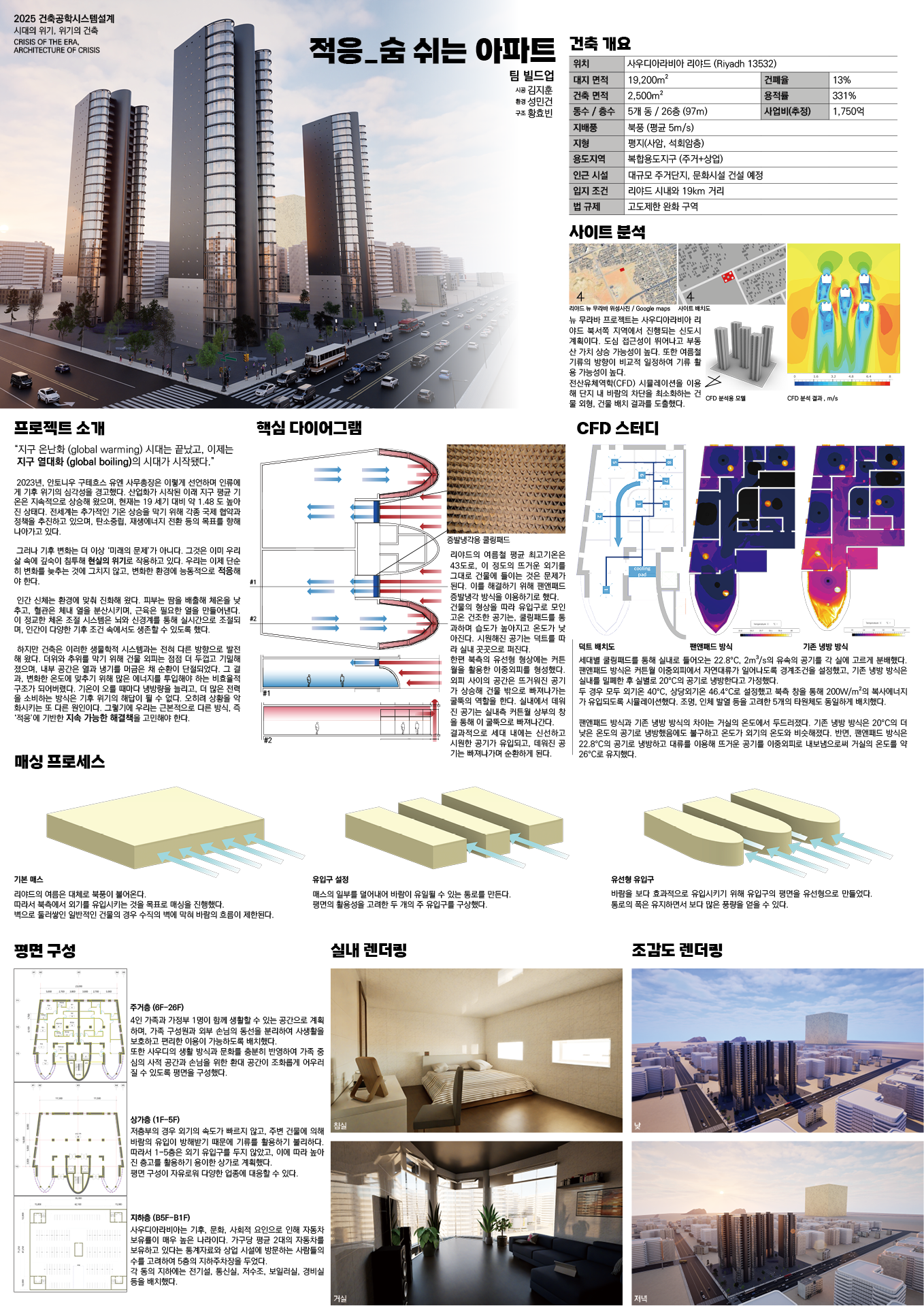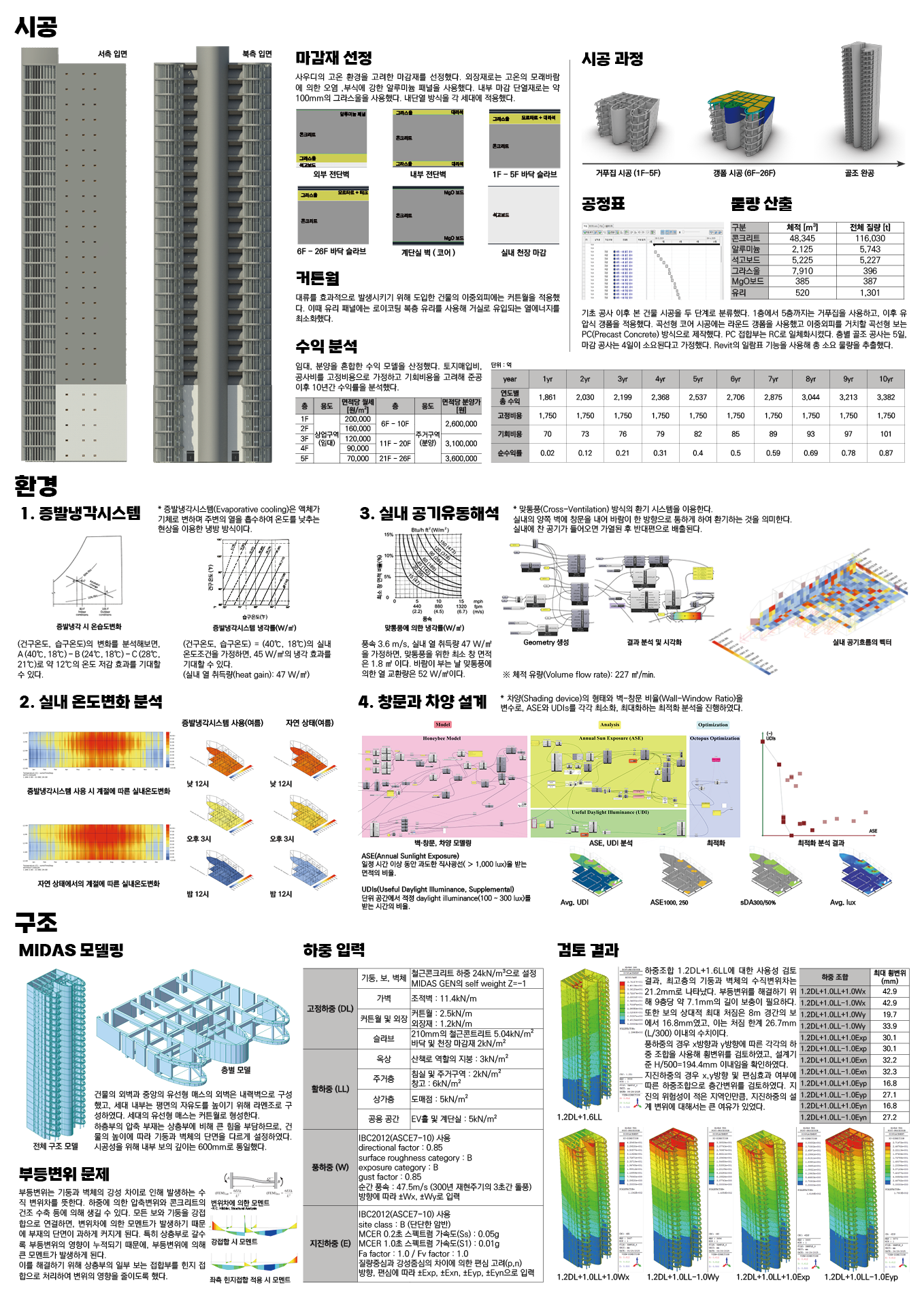빌드업 (김지훈, 성민건, 황효빈) _ 적응_숨 쉬는 아파트
“지구 온난화 시대는 끝났고, 이제는 지구 열대화(global boiling)의 시대가 시작됐다.”
2023년, 안토니우 구테흐스 유엔 사무총장은 이렇게 선언하며 인류에게 기후 위기의 심각성을 경고했다. 산업화가 시작된 이래 지구 평균 기온은 지속적으로 상승해 왔으며, 현재는 19세기 대비 약 1.55도 높아진 상태다.
전 세계는 추가적인 기온 상승을 막기 위해 각종 국제 협약과 정책을 추진하고 있으며, 탄소중립, 재생에너지 전환 등의 목표를 향해 나아가고 있다. 그러나 기후 변화는 더 이상 ‘미래의 문제’가 아니다. 그것은 이미 우리 삶 속에 깊숙이 침투해 현실의 위기로 작용하고 있다. 우리는 이제 단순히 변화를 늦추는 것에 그치지 않고, 변화한 환경에 능동적으로 적응해야 한다.
인간 신체는 환경에 맞춰 진화해 왔다. 피부는 땀을 배출해 체온을 낮추고, 혈관은 체내 열을 분산시키며, 근육은 필요한 열을 만들어낸다. 이 정교한 체온 조절 시스템은 뇌와 신경계를 통해 실시간으로 조절되며, 인간이 다양한 기후 조건 속에서도 생존할 수 있도록 했다. 그러나 건축은 이러한 생물학적 시스템과는 전혀 다른 방향으로 발전해 왔다. 더위와 추위를 막기 위해 건물 외피는 점점 더 두껍고 기밀해졌으며, 내부 공간은 열과 냉기를 머금은 채 순환이 단절되었다. 그 결과, 변화한 온도에 맞추기 위해 많은 에너지를 투입해야 하는 비효율적 구조가 되어버렸다. 기온이 오를 때마다 냉방량을 늘리고, 더 많은 전력을 소비하는 방식은 기후 위기의 해답이 될 수 없다. 오히려 상황을 악화시키는 또 다른 원인이다. 그렇기에 우리는 근본적으로 다른 방식, 즉 ‘적응’에 기반한 지속 가능한 해결책을 고민해야 한다.
그 해답 중 하나로 우리는 ‘기류’라는 키워드를 제시하고자 한다. 사람의 몸이 땀을 흘리고 바람에 의해 식는 것처럼, 건물 역시 외부 환경에 맞게 능동적으로 호흡하며 열을 조절하는 유기적 존재로 거듭나야 한다. 물의 증발을 통해 유입되는 외기의 온도를 낮추는 방식이나, 실내의 더운 공기를 자연스럽게 빼내고 외부의 신선한 공기를 효과적으로 유입해 순환하는 방식이 그렇다. 이는 에너지 소비를 줄이면서 쾌적한 실내 환경을 유지할 수 있는 대안적 건축 전략이다.
건축은 더 이상 외부로부터 몸체를 격리하는 구조가 되어서는 안 된다. 환경과 함께 호흡하고, 변화에 순응하며, 자율적으로 반응하는 생명체 같은 건축이 필요하다. ‘기류’는 단순한 바람이 아니라, 지속 가능성을 향한 새로운 건축 언어의 시작이다.
“The era of global warming has ended, The era of global boiling has arrived.”
In 2023, Antonio Guterres, Secretary-General of the United Nations, warned humanity about the severity of the climate crisis. Since the beginning of industrialization, the Earth’s average temperature has steadily risen and is now about 1.55 degrees Celsius higher than in the 19th century.
The world is implementing various international agreements and policies to prevent further temperature increases, pursuing goals such as carbon neutrality and the transition to renewable energy. However, climate change is no longer a problem of the ‘future’. It has already penetrated deeply into our daily lives and has become a real crisis. Now, we must go beyond merely delaying change and actively adapt to the transformed environment.
The human body has evolved to adjust to its surroundings. The skin releases sweat to lower body temperature, blood vessels disperse internal heat, and muscles generate the heat needed for survival. This sophisticated thermoregulation system is controlled in real time by the brain and nervous system, allowing humans to survive under diverse climatic conditions. In contrast, architecture has developed in a completely different direction from this biological system. To block heat and cold, building envelopes have become thicker and more airtight, while interior spaces have become isolated, trapping heat or cold air inside without circulation. As a result, buildings now require excessive energy input to maintain comfortable temperatures. Increasing cooling capacity and consuming more electricity every time the temperature rises cannot be the solution to the climate crisis; it only exacerbates the problem. Therefore, we must seek fundamentally different approaches—sustainable solutions based on ‘adaptation’.
One such solution is ‘airflow’. Just as the human body sweats and cools in the breeze, buildings should become organic entities that breathe in response to the external environment and actively regulate heat. For example, lowering incoming air temperatures through evaporative cooling or naturally expelling warm indoor air while effectively bringing in fresh outdoor air to maintain circulation are such methods. These are alternative architectural strategies that can maintain a comfortable indoor environment while reducing energy consumption.
Architecture should no longer isolate itself from the outside world. Instead, we need buildings that breathe with the environment, adapt to changes, and respond autonomously—like living organisms. ‘Airflow’ is not merely a breeze; it is the beginning of a new architectural language for sustainability.

